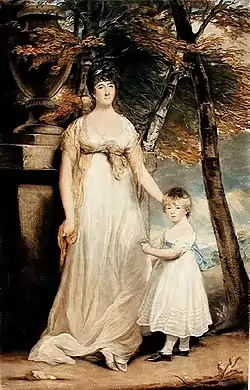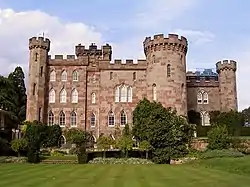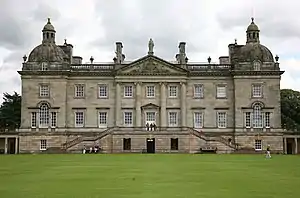William Cholmondeley, 3rd Marquess of Cholmondeley
William Henry Hugh Cholmondeley, 3rd Marquess of Cholmondeley (/ˈtʃʌmli/; 31 March 1800 – 16 December 1884), styled Lord Henry Cholmondeley from 1815 until 1870,[1] was a British peer and Conservative Member of Parliament.[2]
The Marquess of Cholmondeley | |
|---|---|
 Lord Cholmondeley in 1832 | |
| Personal details | |
| Born | William Henry Hugh Cholmondeley 31 March 1800 |
| Died | 16 December 1884 (aged 84) Houghton Hall, Norfolk, England |
| Citizenship | British |
| Nationality | British |
| Political party | Conservative |
| Spouse(s) | Marcia Arbuthnot
(m. 1825; died 1878) |
| Children | 8 |
| Parents | George Cholmondeley, 1st Marquess of Cholmondeley Lady Georgiana Charlotte Bertie |
| Education | Eton College |
| Occupation | Politician and peer |
Family and education

Cholmondeley was the younger of two sons born to George, Fourth Earl of Cholmondeley, who was created the first Marquess of Cholmondeley in 1815. His mother was Lady Georgiana Charlotte, second daughter and co-heir of Peregrine Bertie, 3rd Duke of Ancaster and Kesteven. He was a direct descendant of Sir Robert Walpole, the first Prime Minister of Great Britain.[3][4]
Like his grandfather, and his elder brother, Cholmondeley was educated at Eton. He then attended Christ Church, Oxford, but apparently left without a degree, as was relatively common among his generation.[2] Cholmondeley's elder brother, George, succeeded to his father's title in 1827 as the 2nd Marquess of Cholmondeley.[3]
Career
In 1822, Cholmondeley was elected to the House of Commons for Castle Rising, a seat he held until 1832, when the constituency was abolished by the Reform Bill. He remained out of Parliament for the next twenty years. In 1852, Cholmondeley was again successful for South Hampshire, representing it for the next five years until 1857.[4]
Cholmondeley was a member of the Canterbury Association from 27 March 1848.[5]
In 1870, Cholmondeley succeeded to his elder brother's title as the third Marquess of Cholmondeley and entered the House of Lords.[4]
Marriage and issue

On 28 February 1825, Cholmondeley married Marcia Emma Georgiana Arbuthnot, daughter of Charles Arbuthnot,[3] at Cholmondeley House, which was then in Piccadilly, London. They had eight children, of whom only two daughters survived him:[2][4]
- Marcia Charlotte Emma (22 November 1826 – 7 April 1828)
- Lady Charlotte Georgiana (4 February 1828 – 17 August 1912)
- Charles George (9 July 1829 – 7 December 1869)
- Lady Marcia Susan Harriet (18 April 1831 – 10 June 1927)
- Lord Henry Vere (4 October 1834 – 25 February 1882)
- Emma Caroline (11 November 1837 – 26 January 1839)
- Caroline Rachel (4 July 1840 – 11 March 1863)
Lands and estates

The family seats are Houghton Hall, Norfolk, and Cholmondeley Castle, which is surrounded by a 7,500 acres (30 km2) estate near Malpas, Cheshire.[6]
The Marquess was a teetotal Quaker and closed all the alehouses on the estate.[7]
Position at court
One moiety part of the ancient office of Lord Great Chamberlain is a Cholmondeley inheritance.[8] This hereditary honour came into the Cholmondeley family through the marriage of the first Marquess of Cholmondeley to Lady Georgiana Charlotte Bertie, daughter of Peregrine Bertie, 3rd Duke of Ancaster and Kesteven.[9] The second, fourth, fifth, sixth and seventh holders of the marquessate have all held this office, but Lord William did not take on the responsibilities of this court function.
Death and succession
Cholmondeley's wife died in 1878. Six years after her death, he himself died at Houghton Hall, aged 84. As both of his sons had died before him, Cholmondeley was succeeded in his titles by his grandson George, Earl of Rocksavage, who was the eldest son of his eldest son, Charles.[2]
Houghton Hall was leased out after his death in 1884 until 1916, after which it was restored by the 5th Viscount. Cholmondeley Castle was occupied by the 4th Marquess, who was fatally injured there.
References
- "The Late Marquis of Cholmondeley". The Times. The Times Digital Archive. 10 May 1870. p. 5.
- "Obituary: Marquis of Cholmondeley". The Times. The Times Digital Archive. 18 December 1884. p. 7.
- Lodge, Edmund. (1877). The Peerage and Baronetage of the British Empire as at Present Existing, p. 125.
- Mosley, Charles, ed. (2003). Burke's Peerage, Baronetage & Knighthood (107 ed.). Burke's Peerage & Gentry. pp. 784–785. ISBN 0-9711966-2-1.
- Blain, Rev. Michael (2007). The Canterbury Association (1848–1852): A Study of Its Members' Connections (PDF). Christchurch: Project Canterbury. pp. 20–21. Retrieved 20 March 2013.
- Caroline, Donald. "The new garden at Houghton Hall, King’s Lynn, Norfolk," The Times (UK). 11 May 2008.
- Midgley, Carol. "The Cholmondeley people," The Times (UK). 5 July 2003.
- Notes and Queries (1883 Jan–Jun), p. 42.
- Portcullis: Deed of Covenant and Agreement between Lord Willoughby de Eresby, The Dowager Marchioness of Cholmondeley and the Marquis of Cholmondeley re the exercise of the Office of Hereditary Great Chamberlain (16 May 1829).
External links
- Hansard 1803–2005: contributions in Parliament by the Marquess of Cholmondeley
- Houghton Hall
- Cholmondeley Castle
| Parliament of the United Kingdom | ||
|---|---|---|
| Preceded by Earl of Rocksavage Fulk Greville Howard |
Member of Parliament for Castle Rising 1822–1832 With: Fulk Greville Howard |
Constituency abolished |
| Preceded by Lord Charles Wellesley Henry Combe Compton |
Member of Parliament for South Hampshire 1852–1857 With: Henry Combe Compton |
Succeeded by Sir Jervoise Clarke-Jervoise Ralph Heneage Dutton |
| Peerage of the United Kingdom | ||
| Preceded by George Horatio Cholmondeley |
Marquess of Cholmondeley 1870–1884 |
Succeeded by George Henry Hugh Cholmondeley |
_coa.png.webp)